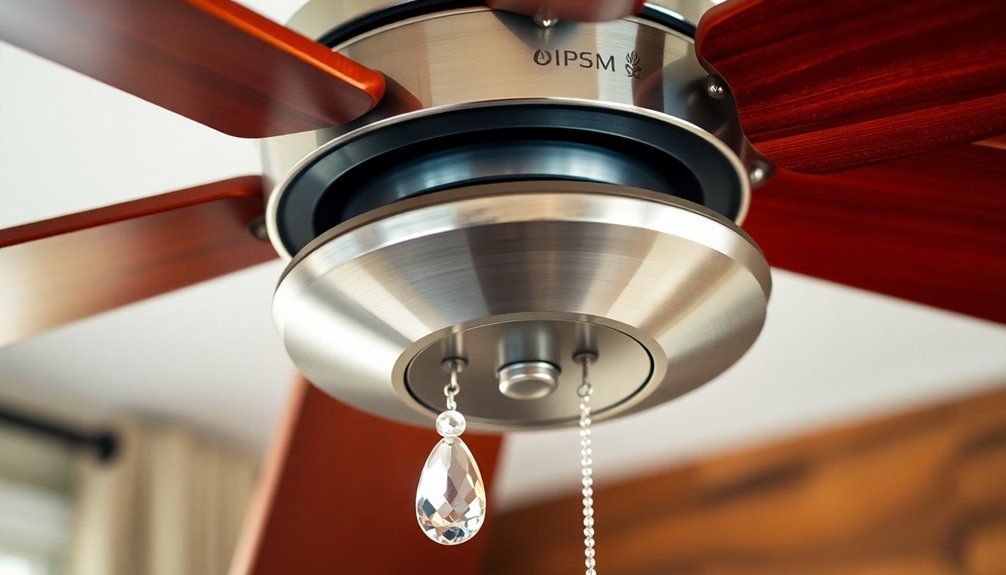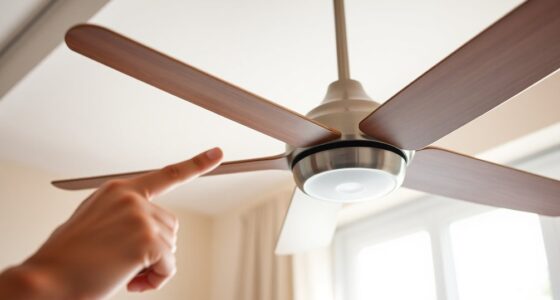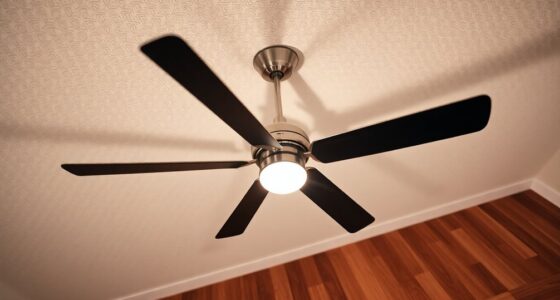Identifying your ceiling fan's brand is easy if you know where to look. Start by checking the motor housing for an ID sticker, usually marked with "MOD" and found on the top of the motor or mounting bracket. Examine the blades for unique designs and materials, as these can hint at the manufacturer. Don't forget to inspect the control unit for logos or model numbers. Certifications like UL or ETL may also reveal brand details. If you keep exploring, you'll uncover even more tips and tricks to narrow it down further.
Key Takeaways
- Check the ID sticker on the motor housing for the model number and brand information.
- Examine the blade design, material, color, and finish, as these can indicate the manufacturer.
- Inspect the mounting system for specific types and features that may correlate with certain brands.
- Assess the control unit for logos, model numbers, and unique features that may help identify the fan's brand.
- Review any available documentation, including the installation manual, for model numbers and manufacturer details.
Check the Motor Housing
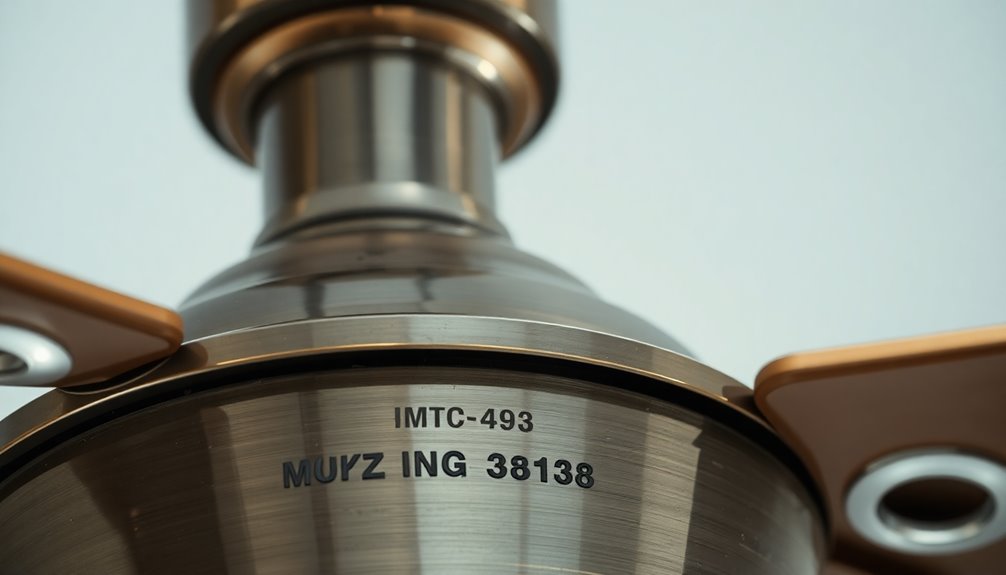
When identifying your ceiling fan brand, the motor housing is a key area to check. For downrod-mount fans, look for the ID sticker on top of the motor housing, facing the ceiling; the model number follows "MOD."
If you have a low-profile fan, the sticker's on the mounting bracket. Casablanca fans might've longer, alphanumeric model numbers located on various parts. To spot a Hunter fan, search for the emblem or embossing on the housing, but remember, its absence doesn't guarantee it's not a Hunter. Some fans might show manufacturer info from other brands, like ChienLuen Industries or Hampton Bay.
You can drop the canopy or use a mirror to better view hidden markings. Model numbers are essential for identifying specific fan models and are crucial for warranty and replacement parts.
Examine the Blades
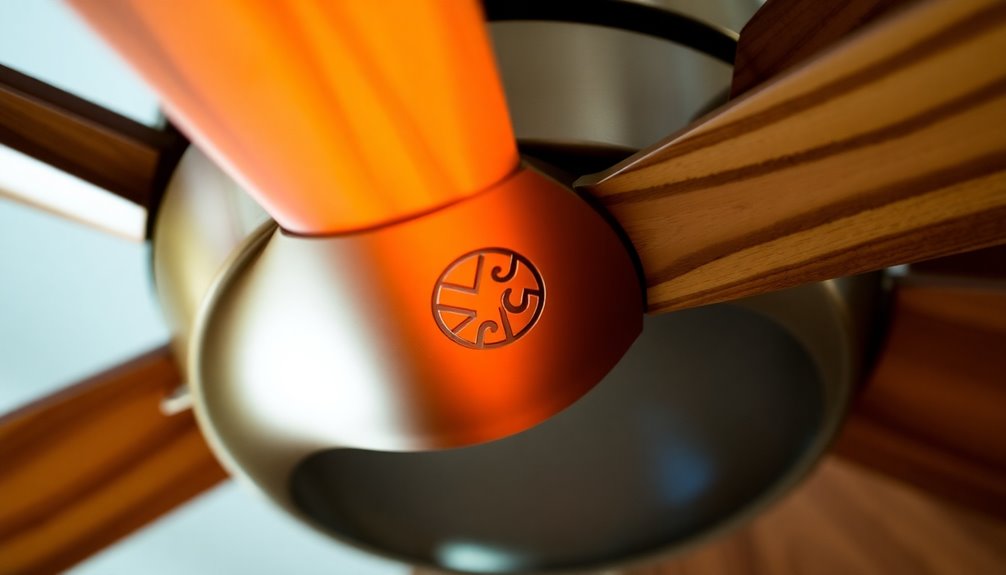
The blades of your ceiling fan play an essential role in both its functionality and aesthetic appeal.
Start by examining the blade design; unique shapes and patterns can hint at the manufacturer. Notice the material, whether it's wood, metal, or plastic, as each brand often has a signature style.
Take a look at the color and finish, too, since some brands offer customizable options. Don't forget to check the size and shape variations, which can also indicate specific brands.
Count the number of blades and observe their spacing; this can reveal brand-specific features.
Finally, consider any durability indicators, like grain patterns on wood or finish types on metal, that can help you narrow down your options.
Inspect the Mounting System
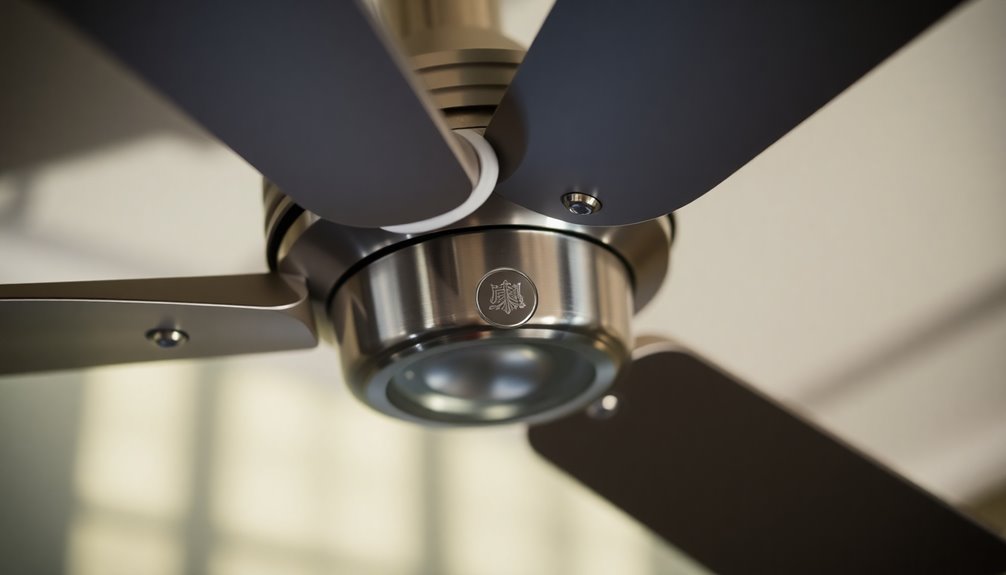
Inspecting the mounting system of your ceiling fan is essential for identifying its brand and guaranteeing safe installation.
Start by identifying the type of mount—whether it's standard, extended, flush, or sloped. Each type serves a different purpose and can hint at the brand. Ceiling fan types can vary widely, so understanding the specific mount can help narrow down the options.
Next, check for manufacturer-specific features like universal ceiling mounts or heavy-gauge steel construction, which could indicate quality and brand reliability.
Examine the downrod for material and length; it should be appropriate for your ceiling height.
Finally, look for brand-specific labels or nameplates that display the model number and manufacturer. These details will help you determine the brand and guarantee your ceiling fan is installed safely.
Assess the Control Unit
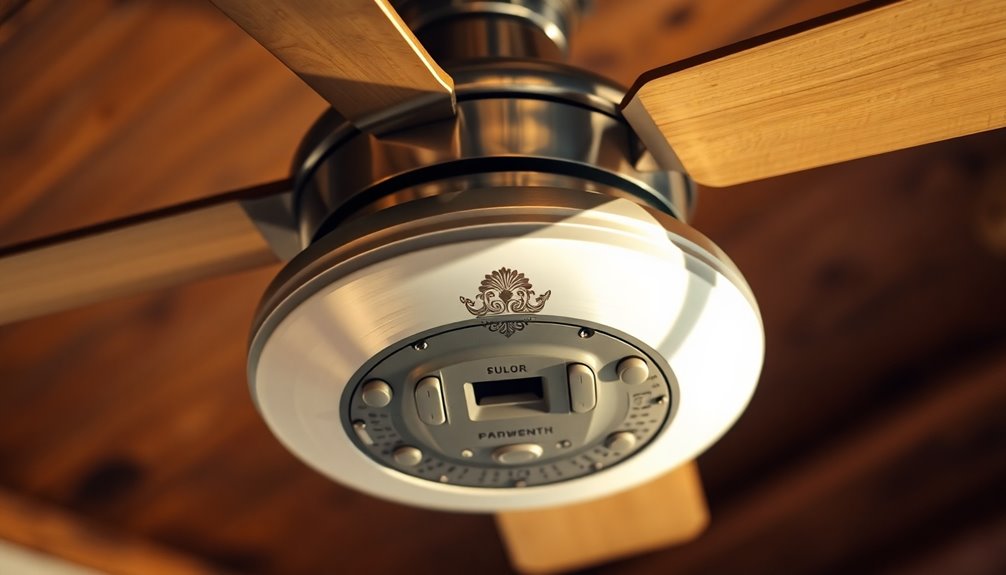
To effectively identify your ceiling fan's brand, start by evaluating the control unit, as it often contains distinct features that set brands apart.
Look for any logos or emblems; Hunter fans usually have a clear embossing on the motor housing, while Hampton Bay or Emerson might feature different branding.
Check for stickers or labels that include model numbers like "Model No. 520ANT" and manufacturer information, which can reveal the brand. Manufacturer labels can often be located on the top side of the motor housing.
If your fan has a remote control, examine its features—unique options like Nature Breeze can help pinpoint the brand.
Finally, consider the design elements, such as color schemes, button layout, and material quality, as these details can give you valuable clues about your ceiling fan's identity.
Look for Certifications
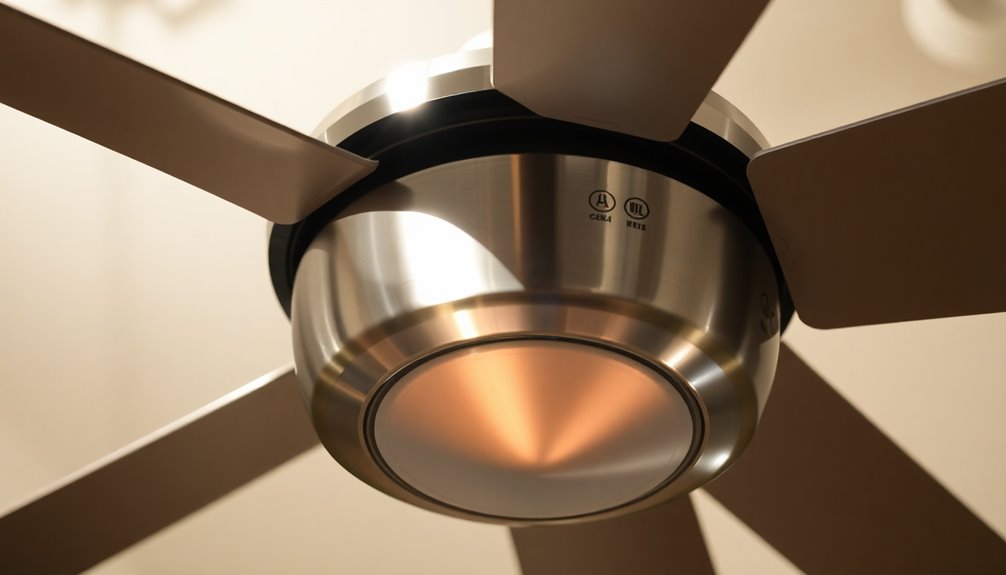
As you explore your ceiling fan, looking for certifications can provide important clues about its brand and safety standards.
Check for the UL Mark, which indicates that your fan meets rigorous safety requirements for its components like the motor and wiring.
The ETL Mark also guarantees that your fan complies with safety and performance standards, covering elements such as blades and remote controls.
If your fan has smart features, look for the FCC Mark, which assures it won't interfere with other electronic devices. These marks signify compliance with safety standards that enhance consumer trust in product safety.
These certifications help you identify reputable brands while guaranteeing the safety and quality of your ceiling fan.
Always prioritize these marks when evaluating your fan's reliability and compliance with industry standards.
Review Documentation
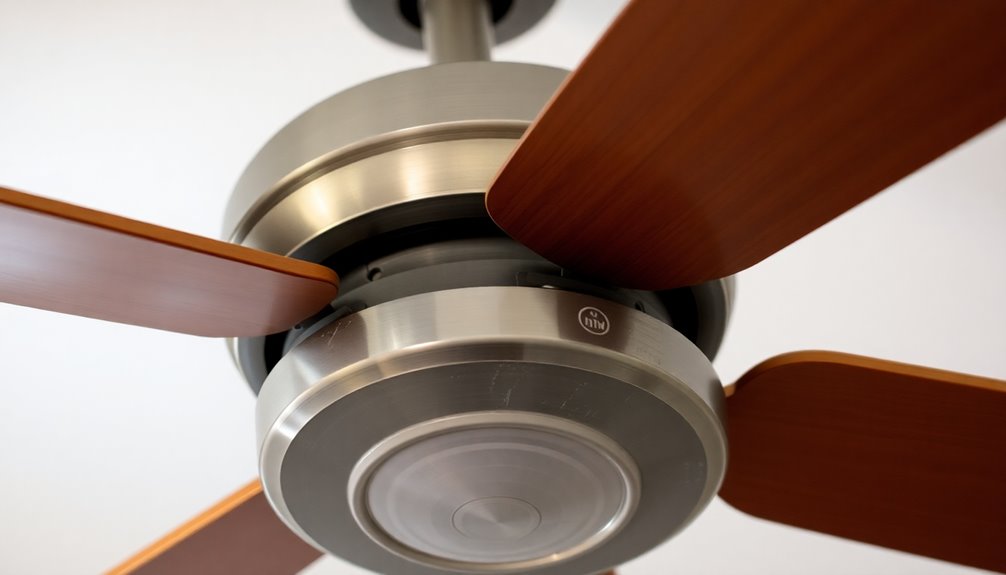
While you might overlook it, reviewing the documentation that comes with your ceiling fan is an essential step in identifying its brand and model.
Start by checking the installation manual, where you'll typically find the model number in the lower corner, alongside the manufacturer's name and contact details. Identifying the make and model is crucial for safety and maintenance.
If you still have the fan box, look for additional product specs printed on it.
Don't forget to inspect the motor housing and mounting bracket for any ID stickers. Use a mirror or smartphone for hard-to-reach areas.
Document the model number and any unique features to help with future identification.
This straightforward approach can greatly simplify your search for the correct brand information.
Utilize Online Resources

How can online resources simplify the process of identifying your ceiling fan's brand?
Start by using search engines to look up your ceiling fan's model number. This can lead you directly to the brand information.
Websites like Home Depot or Lowe's offer tools for brand identification as well.
Consider checking specialized databases like iFixit, or joining community forums on platforms like Reddit, where users share their experiences.
Manufacturer websites can also help; look for product catalogs or customer support options.
Don't forget online marketplaces like Amazon or eBay, where you can search for your model number.
Engaging in social media groups focused on home improvement might provide additional insights from fellow DIY enthusiasts.
Frequently Asked Questions
Can I Identify the Brand by the Fan's Color or Finish?
You can sometimes identify a ceiling fan's brand by its color or finish, but it's not always reliable.
Many manufacturers offer similar hues and styles, making it tough to pinpoint a specific brand just based on appearance. This makes it essential for consumers to look beyond aesthetics when choosing a product. For instance, some brands may incorporate unique cultural associations in their designs, such as the yellow chrysanthemum symbolism for new year, which represents prosperity and rebirth in various traditions. By understanding these deeper meanings, buyers can make more informed decisions that resonate with their personal values and celebrations.
Instead, focus on unique design elements like blade shape or motor housing.
If you spot distinctive logos or patterns, that's a better clue.
Are Specific Brands Known for Particular Noise Levels?
You won't believe how quiet some ceiling fans can be!
Brands like Minka-Aire are renowned for whisper-quiet operation, thanks to their DC brushless motors.
Hunter fans are also impressive, offering WhisperWind motors that deliver strong airflow with minimal noise, though a few might tick slightly.
Westinghouse Lighting and Ensenior fans excel in silence too, making them perfect for bedrooms.
If you're after tranquility, these brands are your best bet for peaceful airflow.
How Can I Tell if My Fan Is a Replica or Original?
To tell if your fan's a replica or original, start by examining the manufacturer's logo on visible parts like the motor housing or blades.
Look for a serial number or model number, as these can help you cross-reference online.
Inspect the design elements, blade shape, and motor housing for authenticity.
If you have the user manual or packaging, check those for brand details, or contact customer support for confirmation.
What Should I Do if I Can't Find Any Identifying Marks?
Imagine trying to find your way in a foggy forest without a map.
If you can't find any identifying marks on your ceiling fan, start by checking the user manual or installation guide—you might discover valuable details there.
Inspect the motor housing for labels, and use a mirror if needed.
If you're still stuck, consider reaching out to customer service or consulting an electrician for help.
Don't lose hope; solutions are out there!
Do Different Brands Offer Unique Warranty Lengths or Terms?
Yes, different brands do offer unique warranty lengths and terms.
For instance, Hampton Bay provides a lifetime motor warranty and extended options, while most other brands typically offer a standard one-year warranty.
Some brands may have model-specific warranties that vary greatly.
Always check the warranty details before purchasing, and don't forget to register your fan if required to guarantee you get full coverage during the warranty period.
Conclusion
In your quest to identify your ceiling fan's brand, remember that each component tells a story. By examining the motor housing, blades, and other features, you're not just searching for a label; you're uncovering the craftsmanship behind your fan. So, whether it's the sleek design or the control unit's functionality, every detail matters. With the right approach, you'll soon know not just what brand you have, but also the quality and heritage it brings to your space.
